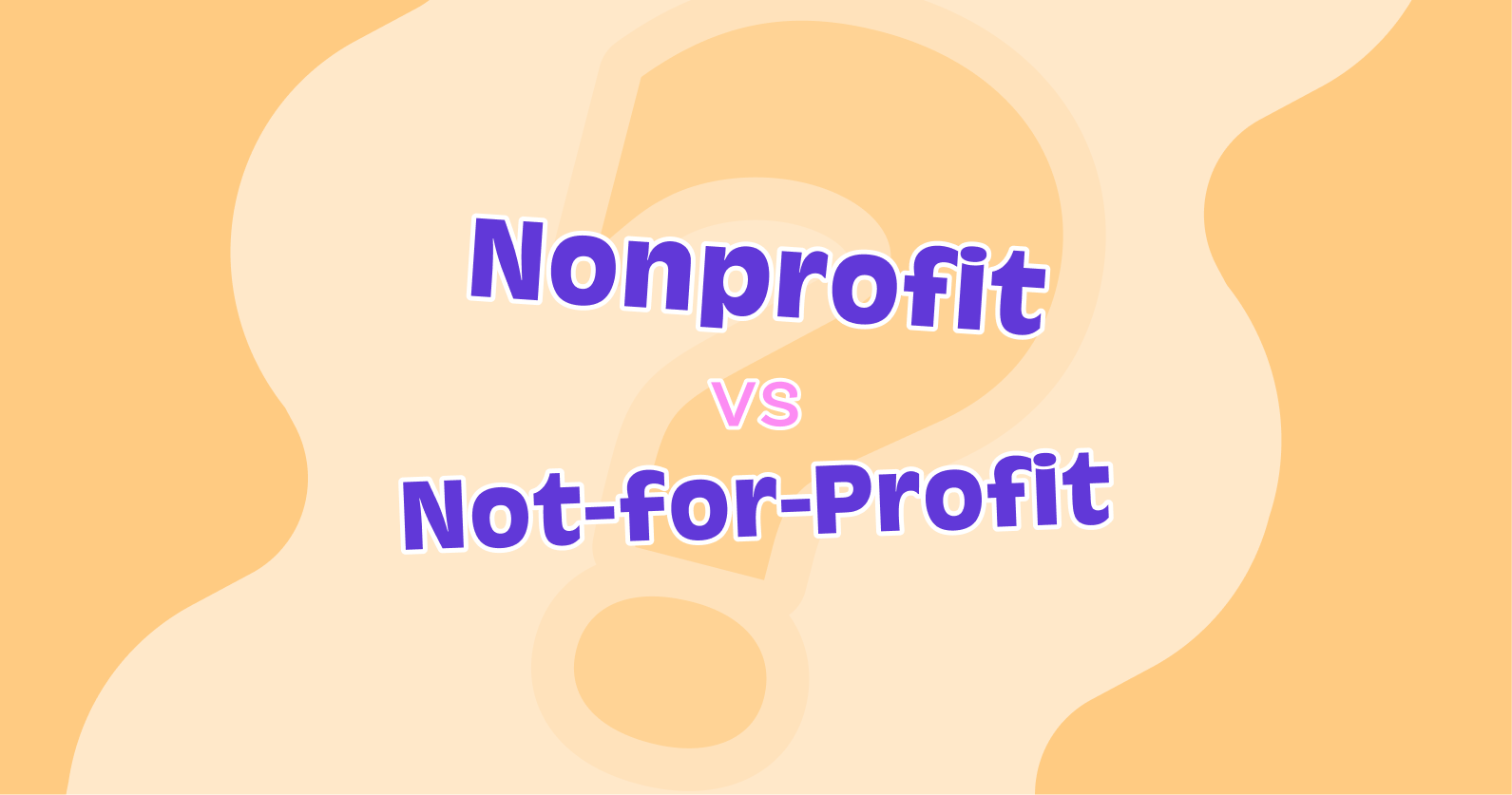
Not-for-profit vs. nonprofit organisations: What it means in the U.S.
For charities based in the U.S., understanding not-for-profit vs. nonprofit status is important yet a bit confusing. Here’s what to know.
In the United States, there are several types of organisations that qualify for tax breaks because they serve a social cause or public good. These organisations usually provide service, advocacy, or funding, like a food pantry, research foundation, sports club, or social welfare organisation.
If you’re raising money for a good cause and you’re in the U.S., you may want to get an understanding of your organisation’s tax-exempt status or take the initiative to apply for tax exemption yourself.
Different categories of tax-exempt organisations have their own specific requirements about what purposes and populations they serve, how they can collect and spend money, what kinds of records they need to keep, and how they can employ staff or volunteers. This is all good stuff to know for your peace of mind as a fundraising coordinator, and there’s a good chance your donors will ask about it.
The main difference is whether your group serves the interests of its members (not-for-profit) or the general public (nonprofit). The terms “nonprofit” and “not-for-profit” aren’t technically defined in Internal Revenue Service (IRS) tax code, so you may see them used interchangeably. It’s frustrating, to say the least!
There are a few other things to consider when comparing not-for-profit vs. nonprofit status in the U.S., which we’ll explore in this article.
What’s a nonprofit?
A nonprofit organisation (NPO) is established for the public good, with a mission to carry out fundraising efforts for charitable purposes.
Nonprofits rely on donations, grants, and sponsorships to operate, and some may sell products or services too. They’re required to publish annual reports showing where their money came from and how it was spent. If you need to send financial reports to the IRS, Raisely’s visual report builder makes it easy to organise data on your fundraising efforts.
Because nonprofits must provide a public benefit, there are a ton of rules about the people and causes they can support. Nonprofits must state in their articles of incorporation that they don’t support political causes and that no personnel or associates will receive a personal gain or benefit from the organisation. A nonprofit can have paid employees, but may only pay them what’s considered fair compensation for their labour.
Nonprofits qualify for complete tax exemption under Internal Revenue Code section 501(c)(3), which uses the term “charitable organisations.” This means the organisation pays no taxes on the money it raises or payroll for employees, and gifts are tax-deductible for donors as well.
To qualify for 501(c)(3) status with the IRS, a nonprofit organisation in the U.S. must be incorporated as a legal entity at the state and federal levels. However, every state has its own rules about the required articles of incorporation.
During the incorporation process, you’ll need to:
- Give your organisation an original name
- Develop articles of incorporation and pay a fee to file in your state
- Create financial projections
- Write bylaws
- Appoint a board of directors and hold your first meeting
- Apply for a federal employer identification number (EIN)
- Apply for any local or state-level licences or permits you’ll need to operate
What’s a not-for-profit?
A not-for-profit (NFPO) is established for the benefit of its members, with a mission to provide a specific type of advocacy, support, funding, insurance, or recreation.
Examples of not-for-profits include sports clubs, social groups, and organisations that operate for scientific, religious, or public safety purposes. They may subsist on dues from members, fundraisers, the sale of donated items, or even bingo games. Not-for-profits don’t generate revenue the way nonprofits and for-profit businesses do, so the money they raise must only be used for pursuing the group’s objectives and paying its running costs.
Not-for-profits usually qualify for some tax exemptions, like income tax, sales tax, or property tax, but not to the same extent as nonprofits. Specifically, gifts to not-for-profits aren’t tax-exempt for donors.
This means the rules for not-for-profits are less restrictive, so some support political causes. However, a not-for-profit can’t distribute profits to its owners. Many not-for-profits are run by volunteers, but some are staffed with part- or full-time employees. These organisations usually aren’t incorporated as separate legal entities.
The steps to becoming a not-for-profit are:
- Give your organisation an original name
- Write bylaws
- Appoint a board of directors and hold your first meeting
Optional
- Develop articles of incorporation and pay a fee to file in your state
- If you plan to hire employees, apply for a federal employer identification number (EIN)
- Apply for IRS 501 designation
Who’s tax exempt? IRS Code Section 501(c)
Hopefully your head isn’t spinning too much at this point. Unfortunately, understanding the differences between nonprofits and not-for-profits means getting into the nitty gritty of the U.S. tax code. Not exactly easy reading!
Internal Revenue Code section 501(c) outlines the different types of tax-exempt organisations. Again, nonprofit organisations are those registered as 501(c)(3)s, and only some not-for-profits qualify for certain tax breaks. Both types of organisations apply for tax exemptions with the IRS by filing Form 1023, 1023-EZ, 1024, or 1024-A.
If you’re comparing nonprofit vs. not-for-profit status, the biggest benefits of becoming a nonprofit under section 501(c)(3) are that donations are tax-deductible and you’re exempt from income taxes on the funds you raise. There are a few other perks, such as limited protection from lawsuits, eligibility to receive grants, and discounts such as lower postage rates and nonprofit advertising rates.
Not-for-profit vs. nonprofit: Key differences
We know this is confusing stuff! To recap what we’ve covered, here’s a breakdown of the key differences in the not-for-profit vs. nonprofit conundrum:
- Nonprofits always operate for the public benefit while not-for-profits may operate for the benefit of their members or the public.
- Nonprofits are required to report their financials to the public while not-for-profits aren’t.
- All nonprofits qualify for tax-exempt status under 501(c)(3), which only some not-for-profits qualify for. This means that all donations to nonprofits are tax deductible, but only some not-for-profits qualify for tax-free fundraising.
- While neither type of organisation technically earns a profit, nonprofits operate more like small businesses and reinvest any “profits” into the organisation. Not-for-profits are more like social clubs or labour unions, so they don’t always plan to grow or fundraise as aggressively.
- Nonprofits are incorporated as their own legal entity while not-for-profits are organisations that may not be incorporated.
Which one should I choose?
The type of organisation you choose ultimately depends on your goals and purposes for establishing and operating. Ask yourself these questions to narrow down what choice may be best for you:
- Do you plan to raise money from the public, collect dues from members, or get funding in another way?
- What’s the purpose of your organisation? Do you support a public good or just the interests of your members?
- Do you plan to pursue revenue goals like a for-profit company or operate more like an association, league, or social club?
Start fundraising with Raisely
Whatever conclusion you come to on not-for-profit vs. nonprofit status, Raisely is your all-in-one fundraising platform.
On Raisely, it’s easy to set up all kinds of fundraising campaigns that’ll get your members involved, from DIY community campaigns and peer-to-peer fundraising to virtual or hybrid events. We’ve included CRM functions so you can manage your audience directly on the platform. Finally, it’s free to create your account and start fundraising!Ready to get out there and make a positive impact? Sign up for your free account to create a donation page and start raising money today.
Ready to create your
next campaign?

Kelsey Hoff is a content marketing specialist, freelance writer, blogger, and poet. She creates emotionally intelligent content that “listens first” for effective, ethical thought leadership.




